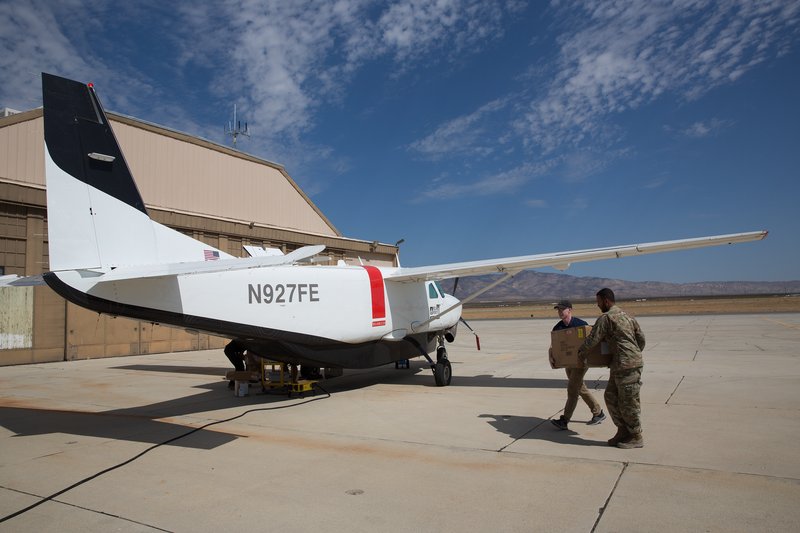US Air Force tests the use of autonomous flying capabilities in austere, contested scenarios
An uncrewed Cessna 208B Grand Caravan departs to deliver cargo (Photo: US Air Force/ Matthew Clouse)
The US Air Force (USAF) has recently tested using autonomous flying capabilities to perform logistics missions in austere, contested scenarios. Conducted during the AGILE FLAG 24-3 exercise at Mojave Air and Space Port, California, the trials involved technologies supplied by Joby and Reliable Robotics.
As part of the Autonomy Prime programme, the systems were used to remotely control a loaded Cessna 208B Grand Caravan during taxi, take off, flying and landing.
The aircraft flew for nearly 2,000km (1,150m) between military bases and airports, delivering 5,500 kg (1,200 pounds) of cargo including parts and supplies.
Related Articles
Preparing for mass deployments and improving aircraft fleet among US Air Force priorities for FY2025
USAF's F-16 to fly pilotless for first time in 2025
US Air Force edges closer to remotely operating the KC-135 Stratotanker
Speaking to Shephard, Maj. Gen. (retired) Dave O'Brien, SVP of government solutions for Reliable Robotics, explained that the test involved “some pretty extreme environments with heat, winds and dust”.
“The operation really mimicked what you would expect to see in a distant theatre of operations,” O'Brien said. “[USAF personnel involved in the exercise] wanted more and more things effectively delivered with a sense of urgency. What the exercise has shown is that this cargo delivery method has got a lot of potential for the USAF”.
Involving the 23rd Wing from Moody Air Force Base, Georgia, and the 9th Reconnaissance Wing from Beale Air Force Base, California, the demonstrations intended to evaluate whether this type of capabilities can accelerate logistical operations while reducing costs related to fuel, maintenance and crew deployment.
“The savings in time is phenomenal,” O'Brien claimed. “The ability to deliver the precise needed part or whatever to its location, either at or ahead of its need, is a game changer.”
From the budgetary perspective, the average operating cost per hour for a C-130J Hercules is $7,671 and $20,941 for a C-17A Globemaster III, according to the FY2023 Department of Defense cost report.

For an autonomous Cessna 208B Grand Caravan, however, the operating cost per hour is between $1,200 and $1,600.
Col Max Bremer, Air Mobility Command Special Access Programme management officer, asserted: “The return on investment with this technology is significant. By using it to handle smaller cargo, we can preserve cargo aircraft for more critical tasks like transporting large parts, engines, or weapons.”
In Bremer’s opinion, “this not only enhances the overall capability of the cargo fleet but also ensures they are used where they are most needed”.
Under the Autonomy Prime programme, the Prime division of AFWERX, a directorate of the Air Force Research Laboratory (AFRL) awarded Joby and Reliable Robotics Small Business Innovation Research Phases II and III contracts to conduct autonomous flight trials and demonstrate the capability in operationally relevant environments.
Other demonstrations of this initiative were carried in February in California. Controlled by a pilot on the ground, a Cessna 208 Caravan, departed from Sacramento McClellan Airport and landed at Hollister Municipal Airport.
Ian Clowes, Prime stakeholder engagement lead for AFWERX, stressed: “As we continue to refine and scale these capabilities, we hope to see them fully integrated into Air Force operations without the need for intermediaries.”

As Clowes highlighted, “the future is about making these technologies an organic part of how the Air Force fights and wins”.
The service ordered Reliable Robotics to carry out a study to evaluate the integration of the company’s aircraft-agnostic autonomous flight system into large multi-engine aircraft such as the KC-135 Stratotanker.
“Right now, what the Air Force is looking at is sort of the requirements, the planning and how they would operate this aircraft,” O'Brien explained. “We continue to kind of advance the automation delivery roadmap that we have prepared for the KC-135.”
Apart from logistics, the USAF has been also working on several efforts to add uncrewed capabilities to its in-service aircraft. The Viper Experimentation and Next-gen Operations Model – Autonomy Flying Testbed programme (VENOM-AFT), for instance, is planned to fly of a pilotless F-16 Fighting Falcon.
Meanwhile, under the Variable In-flight Simulation Test Aircraft (VISTA) initiative, the branch tested in April a X-62A VISTA aircraft equipped with autonomous flying capabilities.
Related Equipment in Defence Insight
More from Air Warfare
-
![Norway cleared for possible $2.6 billion HH-60W helicopter FMS]()
Norway cleared for possible $2.6 billion HH-60W helicopter FMS
The possible sale for nine HH-60W makes Norway the first Foreign Military Sale customer for the rescue and combat helicopter and adds to the country’s ongoing acquisition of Sikorsky-made helicopters.
-
![France and UK to resume and upgrade Storm Shadow/SCALP production]()
France and UK to resume and upgrade Storm Shadow/SCALP production
The new ‘Entente Industrielle’ will work on a range of other projects to boost the UK economy and defence industry, including joint development on new high-tech frequency weapons and extended range air-to-air missiles.
-
![Boeing E-7A still in South Korean AEW&C competition, despite dropout reports]()
Boeing E-7A still in South Korean AEW&C competition, despite dropout reports
The E-7A is one of three aircraft submitted for the South Korean AEW&C II competition, which seeks to acquire four more aircraft of the type for its air force by 2028.






















